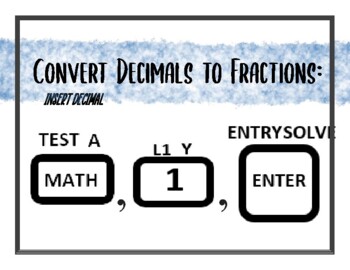TI-84 Graphing Calculator Commands/Help bulletin board posters
Raven Ready
1 Follower
Grade Levels
7th - 12th
Subjects
Resource Type
Standards
CCSS8.EE.A.1
CCSS8.EE.A.2
CCSS8.EE.A.3
CCSS8.EE.A.4
CCSS8.EE.B.5
Formats Included
- PDF
Pages
11 pages
Raven Ready
1 Follower
Description
This is a set of TI- 84 Graphing calculator commands. They were created to be used a posters on a bulletin board to help students with basic calculator steps. They can also be used in other ways. I have 10 posters of commands included and a heading page. I selected the most common used or most commonly forgotten calculator steps that I have experience as a Foundations of Algebra/Algebra teacher .The posters include calculator steps for the following:
- Reset the Calculator
- Convert Fraction to Decimal
- Convert Decimal to Fraction
- Create a Fraction
- Find the GCF of 2 Numbers
- Return to the Home Screen
- Exponents
- Square Root
- Cubed Root
- Absolute Value
TI-84 calculator and buttons:
https://www.teacherspayteachers.com/Store/Math-Clips
Total Pages
11 pages
Answer Key
N/A
Teaching Duration
N/A
Report this resource to TPT
Reported resources will be reviewed by our team. Report this resource to let us know if this resource violates TPT’s content guidelines.
Standards
to see state-specific standards (only available in the US).
CCSS8.EE.A.1
Know and apply the properties of integer exponents to generate equivalent numerical expressions. For example, 3² × (3⁻⁵) = (3⁻³) = 1/3³ = 1/27.
CCSS8.EE.A.2
Use square root and cube root symbols to represent solutions to equations of the form 𝘹² = 𝘱 and 𝘹³ = 𝘱, where 𝘱 is a positive rational number. Evaluate square roots of small perfect squares and cube roots of small perfect cubes. Know that √2 is irrational.
CCSS8.EE.A.3
Use numbers expressed in the form of a single digit times an integer power of 10 to estimate very large or very small quantities, and to express how many times as much one is than the other. For example, estimate the population of the United States as 3 × 10⁸ and the population of the world as 7 × 10⁹, and determine that the world population is more than 20 times larger.
CCSS8.EE.A.4
Perform operations with numbers expressed in scientific notation, including problems where both decimal and scientific notation are used. Use scientific notation and choose units of appropriate size for measurements of very large or very small quantities (e.g., use millimeters per year for seafloor spreading). Interpret scientific notation that has been generated by technology.
CCSS8.EE.B.5
Graph proportional relationships, interpreting the unit rate as the slope of the graph. Compare two different proportional relationships represented in different ways. For example, compare a distance-time graph to a distance-time equation to determine which of two moving objects has greater speed.





